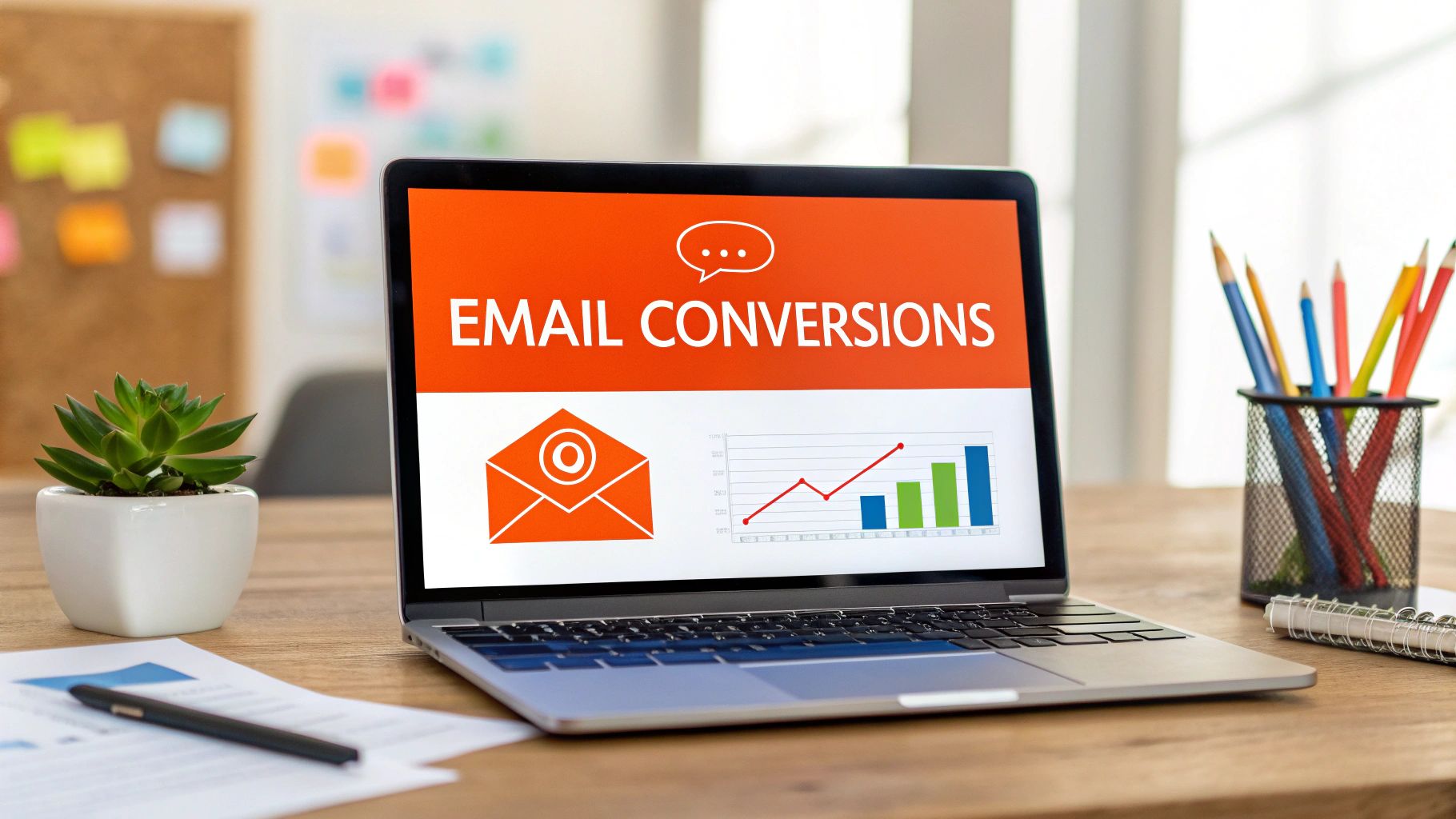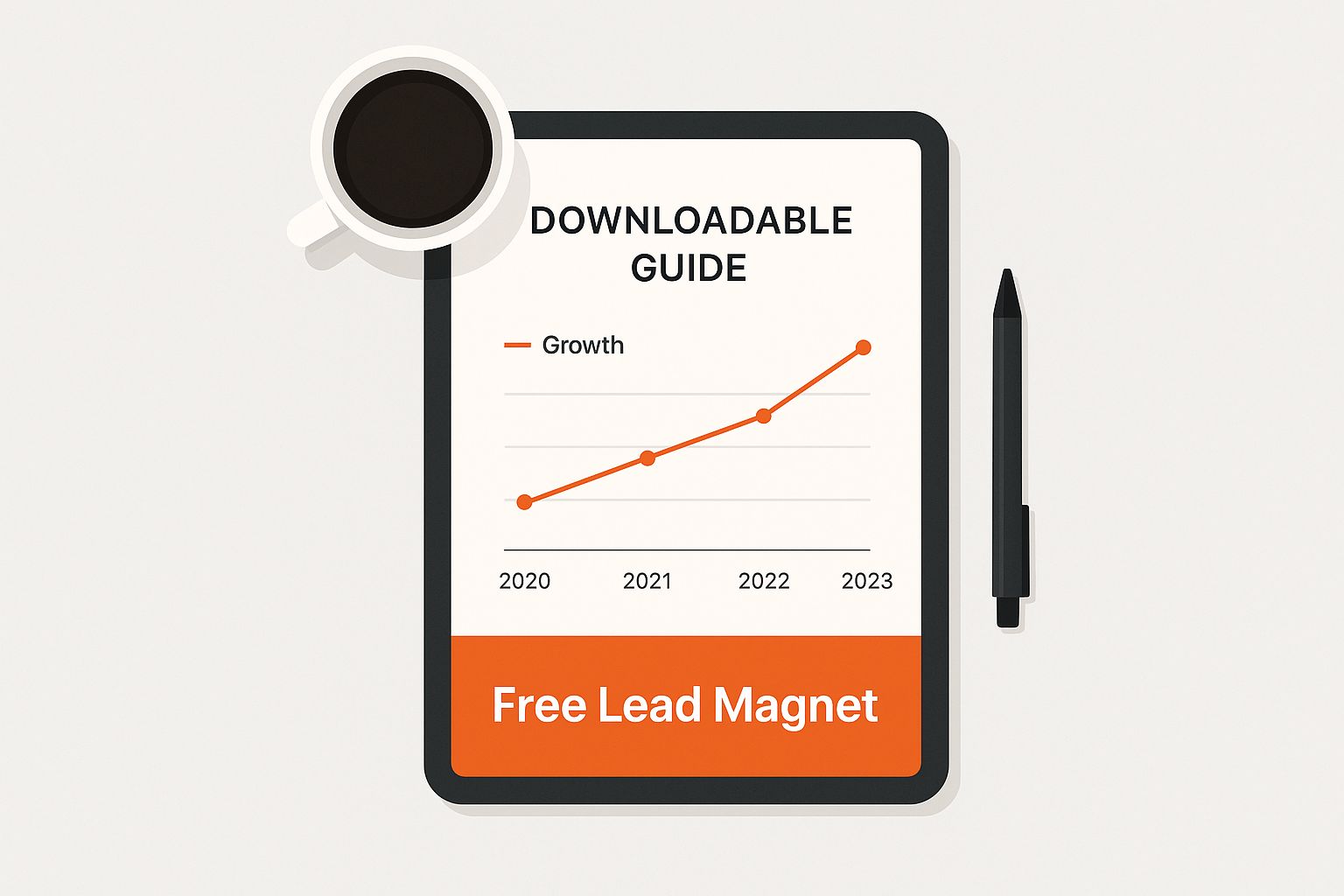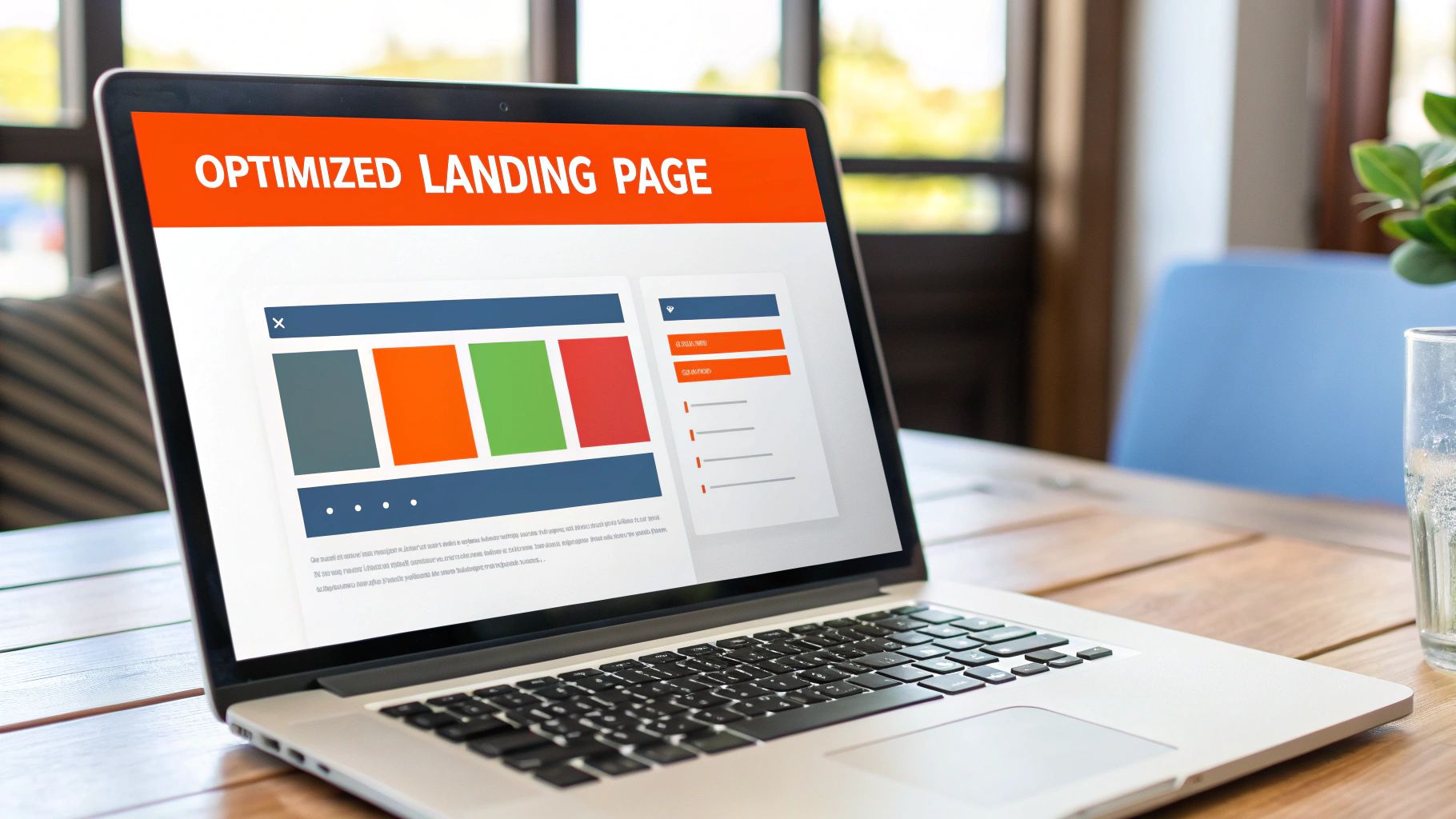
Generating Leads for Email Marketing That Actually Convert
Building your email list is all about forging a direct, reliable connection with the people most interested in what you do. The basic idea is simple: you offer something valuable (a "lead magnet"), and in return, potential customers give you their email address. This simple exchange is how you start turning casual website visitors into a long-term business asset that you completely control.
Why Your Email List is Your Most Resilient Asset
Let's be real. Social media algorithms are a black box, and the cost of paid ads seems to creep up every single quarter. In a digital world that’s constantly shifting under our feet, focusing on generating leads for email marketing isn’t just another item on the to-do list—it's about building a stable foundation for your business.
Think of it this way: your email list is something you actually own. It’s a direct line to your audience, with no gatekeeper deciding who sees your message. Your social media following? That’s just a rented audience on a platform someone else controls. That ownership is what gives you security and real control.
Cultivating Your Most Profitable Channel
Having an owned audience lets you have personalized conversations that are pretty much impossible on a noisy social media feed. Instead of just shouting into the void, you can segment subscribers based on their interests, what they've clicked on, or what they've bought before.
For example, imagine you run an e-commerce store for outdoor gear. You could create a segment of customers who have purchased hiking boots in the past. When a new line of waterproof hiking socks comes in, you send a targeted email only to that segment with the subject line "The Perfect Socks for Your Hiking Boots." That kind of targeting feels genuinely helpful to the customer, not spammy, and it’s what drives way higher engagement and sales. This is the heart of effective email marketing and lead generation—turning broad interest into specific, profitable action.
The true power of an email list is its resilience. Facebook could change its algorithm tomorrow and your reach could plummet overnight. But your email list? That remains a direct, unfiltered channel that you control, period.
The Unbeatable ROI of Email
Beyond the stability, the numbers just make sense. Email marketing consistently delivers an incredible return on investment (ROI). For every dollar you put in, the average return is a massive $36. That's a 3,500% ROI.
And in some sectors, like retail and consumer goods, that number can jump as high as 45-to-1. If you're curious, you can dig into more lead generation statistics and their impact.
At the end of the day, building a quality email list isn't just about hoarding contacts. It’s a strategic play to create a sustainable, profitable marketing channel that protects your business from the whims of other platforms and helps you build real, lasting relationships with customers. It's your most dependable engine for growth, bar none.
Finding Your Audience Where They Already Gather

The best way to generate leads for email marketing isn't to just throw ads into the digital void and hope something sticks. It's about finding out where your ideal customers are already hanging out and joining the conversation. These people are already talking about the exact problems you can solve, making them incredibly valuable prospects.
Think of yourself as a listener first, a marketer second. When you quietly observe the conversations happening in niche forums, specific LinkedIn groups, or tight-knit subreddits, you’re gathering priceless intelligence. Actionable Insight: Keep a simple spreadsheet tracking common questions and phrases. This data is a goldmine for future content, ad copy, and lead magnet ideas.
This kind of deep understanding is what allows you to show up as a genuine expert, not just another person pushing a product. When you lead with real value, people are much more likely to trust you with their email address down the line.
Pinpointing Your Niche Communities
Specificity is your best friend here. Huge, generic groups are often way too crowded and noisy to make a real impact. Your goal is to find those smaller, hyper-relevant communities where real, meaningful discussions are happening every single day.
- B2B SaaS Founders: Instead of getting lost in the massive /r/technology subreddit, you'd have much more success in focused communities like /r/SaaS or a LinkedIn group for "Fintech Professionals."
- E-commerce Brands: If you're selling sustainable home goods, forums about "zero-waste living" or a Facebook group called "Eco-Friendly Home Hacks" are absolute goldmines.
- Content Creators: A podcaster who focuses on productivity should be hanging out in communities for "Notion users" or "Getting Things Done (GTD) enthusiasts."
Diving into social listening is a powerful way to find these digital watering holes. For a deeper look at how to apply this to business, check out this comprehensive guide to social listening for B2B lead generation.
The "Listen First" Approach to Engagement
Before you even think about posting a link, your only job is to understand the culture of the community. Spend time lurking—read the posts, see which comments get the most upvotes, and take note of the questions that pop up over and over again. This isn't just passive scrolling; it's strategic research.
The biggest mistake you can make is barging into a community and immediately promoting yourself. That's a surefire way to get ignored or banned. Real engagement starts by adding value. Answer questions, share what you know without asking for anything in return, and just become a familiar, trusted face.
Once you’ve built up some credibility, you'll start seeing natural opportunities to connect your expertise back to your own resources.
Practical Example: You're in a project management subreddit and see a post titled "My marketing campaigns are always a mess. How do you all stay organized?" Instead of a generic reply, you could write a detailed comment outlining your 3-step process. At the end, add: "This process works well for my team. I actually turned it into a simple Google Sheets template. Happy to share the link if you think it would be useful."
See how that works? It’s not pushy at all. It provides value first and naturally leads interested people toward your solution.
If you’re focusing your efforts on Reddit, it helps to know where to look. You can find a curated list of marketing-focused subreddits to kickstart your research. By becoming a real member of the community first, you create a natural and effective path for lead generation.
Crafting Lead Magnets People Genuinely Want
Let's be honest: the old "subscribe to our newsletter" pop-up is on life support. To get someone's email address today, you need to offer a fair trade. Give them something so genuinely useful, so immediately helpful, that they feel like they’re getting the better end of the deal.
That’s your lead magnet. It isn't just some random freebie; it's a targeted solution to a problem that keeps your ideal customer up at night. The better you solve that specific pain point, the more emails you'll collect.
Think of it as a first impression—a preview of the value you're capable of delivering. If your audience struggles to plan social media content, a vague ebook on "marketing" is just digital noise. But a downloadable "1-Month Social Media Content Calendar Template for Realtors"? That's a tool they can use right now. That’s the kind of tangible value that earns you a spot in their inbox.
Zero In On A Real, Specific Need
The trick is to stop thinking in broad strokes and start focusing on the specific, high-intent problems your audience has. The best place to find these? Look at the exact questions people are asking in the communities you've already scouted.
Here are a few examples of what this looks like in practice:
Audience: B2B SaaS founders struggling with user onboarding.
Lead Magnet: A "New User Onboarding Checklist" that breaks down the crucial steps for a successful first week.
Audience: An e-commerce brand's customers buying fitness gear.
Lead Magnet: A "Printable 30-Day Home Workout Planner" they can stick on the fridge.
Audience: Aspiring podcasters feeling overwhelmed.
Lead Magnet: A "Podcast Launch Kit" with a pre-flight checklist, episode planning template, and a curated list of starter equipment.
Notice a pattern? These work because they're functional. They save time, eliminate confusion, or provide a clear roadmap. This is what effective lead generation is all about. It’s no wonder that in 2025, about 50% of marketers still consider it their number one priority. With organizations generating an average of 1,877 leads per month, there's a huge opportunity for those who get it right. You can dig into more of the latest lead generation trends to see just how critical this is.
A great lead magnet doesn’t just tell someone what to do; it gives them the tool to actually do it. Your goal is to create something that makes your ideal customer think, "Wow, this was made just for me."
Choosing the right format is just as important as the topic itself. The best lead magnet meets your audience where they are, solving a problem in a way that feels easy and immediate for them.
Choosing the Right Lead Magnet for Your Audience
This table breaks down a few popular options to help you match the format to your audience's needs and your own resources.
| Lead Magnet Type | Best For Audience... | Example Scenario | Effort to Create |
|---|---|---|---|
| Checklist | Who needs a quick, actionable framework to follow. They're looking for clarity and don't have time for a long read. | A freelance writer wants a "New Client Onboarding Checklist" to make sure they don't miss any steps. | Low |
| Template | Who wants a "fill-in-the-blank" solution to save time. They know what they need to do but want a shortcut. | A small business owner needs an "Email Outreach Template" to connect with potential partners. | Low-Medium |
| Ebook/Guide | Who is researching a complex topic and needs a deeper understanding. They are willing to invest time to learn. | A marketing manager is exploring "A Beginner's Guide to SEO" before hiring an agency. | High |
| Webinar/Workshop | Who learns best by watching and wants to ask questions directly. They're looking for expert guidance. | A startup team wants to attend a "Live Webinar on Scaling with Google Ads" to learn from an expert. | High |
| Case Study | Who is close to making a decision but needs proof your solution works. They're looking for real-world results. | A SaaS buyer wants to see a "Case Study on How Company X Increased MRR by 30%" with your software. | Medium |
Ultimately, the goal is to create a resource that provides an immediate win. This is how you build trust and start the relationship off on the right foot.

The best lead magnets feel less like a file and more like a product—something with real, tangible value. Get this right, and you won't just be collecting emails; you'll be building an audience that truly wants to hear from you.
Designing Landing Pages That Convert Visitors

You’ve created an incredible lead magnet, but all that hard work is for nothing if the sign-up page falls flat. This is where your landing page comes in. It’s not just another page on your website; it's a specialist, a closer. Its only job is to turn a curious visitor into a new email lead.
A great landing page gets rid of all the noise and makes signing up feel like an obvious, easy win. If your page is confusing or cluttered, even the best lead magnet on earth won't perform. Here, simplicity and a laser-focused message are everything.
The Anatomy of a High-Converting Landing Page
So, what does a landing page that actually works look like? It’s not magic. It’s a combination of a few essential elements that work together to guide someone from interest to action.
- A Headline That Mirrors the Promise: Your headline needs to directly reflect the value you offered. If you promised a "User Onboarding Checklist," the headline better be "Get Your Free User Onboarding Checklist." Actionable Insight: The headline on your landing page should use the exact same wording as the link they clicked to get there. This creates a seamless experience and confirms they're in the right place.
- Concise, Benefit-Driven Copy: People don’t read; they scan. Use bullet points to spell out the benefits. Don't say, "This guide contains marketing tips." Instead, say, "Inside, you'll discover: How to reduce churn by 15%, The #1 mistake new users make, and A 5-minute setup for success."
- Compelling Visuals: Make your freebie feel real. Show a mockup of the checklist, an image of the ebook cover, or a clean screenshot of the template. Visuals make the abstract tangible and increase perceived value.
- Social Proof for Instant Trust: Seeing that other people have already benefited is a powerful motivator. A simple testimonial like, "This template saved me hours of work! - Sarah J., Project Manager" can make a world of difference in your conversion rates.
The golden rule of landing page design is one page, one goal. Strip out your main website navigation, footer, and any other links that could tempt someone to click away. The only way out should be through your form.
Your Call-to-Action and The Opt-in Form
The call-to-action (CTA) button is the single most important element on the page. It has to pop. Use a color that stands out from the rest of the page—like an orange button on a blue background—and write clear, direct copy. "Download Now" or "Get the Checklist" works so much better than a passive "Submit."
Your form needs to be just as efficient. Ask only for what you absolutely need, which is almost always just an email address. Every extra field you add introduces friction and can tank conversions by 10-15%. Make it effortless.
You can even take it a step further than a simple form. Interactive tools like chatbots can engage visitors in a conversation, answer their questions, and then capture their email. If you're looking for an advanced tactic, consider building a chatbot specifically for lead generation to boost your results.
At the end of the day, a great landing page respects the visitor's time. By focusing on clarity, value, and a frictionless sign-up process, you'll successfully convert that traffic into a valuable email list.
Turning New Subscribers into Engaged Fans
Getting that email address is just the beginning. It's the starting line, not the victory lap. The real work starts the second they hit “subscribe.” If all you send is a single, generic ‘thank you’ email, you’re leaving a massive opportunity on the table.
To turn a brand-new lead into a genuine fan, you need a smart, automated welcome sequence. This is your one shot to make a killer first impression. It’s not about blasting them with sales pitches; it's about building trust and proving you’re worth their time. Get this right, and you've set the stage for a long, happy relationship.
Mapping Out Your Welcome Sequence
A solid welcome sequence usually involves 3 to 5 emails spread out over the first week. Each one has a specific job, and they all work together to create a smooth, valuable experience for your new subscriber.
Email 1 (Sent Immediately): Deliver the Goods. The subject line should be direct and clear:
Here's your [Lead Magnet Name]!. In the body, use a prominent button that says "Download Your Checklist Now." This isn't the time for a long story; just deliver the value.Email 2 (Day 2): Make a Proper Introduction. Subject:
So, about [Company Name]...Tell a quick story about why you started your business. Frame it around the problem your customers face. For example: "I started this company because I was tired of marketing tools that were too complicated and expensive for small businesses." This makes your brand relatable.Email 3 (Day 4): Offer a Surprise Bonus. Send them another helpful resource they weren't expecting. Subject:
A little something extra for you. It could be a link to your most-read blog post, a short video tip, or another free template that complements the first one. This builds immense goodwill.
Crafting Content That Actually Connects
What you write in these welcome emails is what turns a casual signup into an engaged follower. The data backs this up—email marketing is a powerhouse for building relationships. The average conversion rate for email hovers around 15.22%, which completely smokes social media platforms, where you're lucky to see 2% to 5%. You can dig deeper into email marketing's powerful conversion rates to see just how effective it is.
Your first few emails set the tone for everything that follows. If you deliver incredible value right out of the gate, people will actually look forward to hearing from you. If you send boring, self-serving fluff, you’ve lost them before you even got started.
Let’s say you’re a SaaS company. After someone downloads your onboarding checklist, your next email could say something like, "Hey [Name], yesterday you grabbed our onboarding checklist. At this stage, a lot of people also find our guide on improving social media engagement tips really helpful."
Finally, wrap up your sequence with a gentle nudge toward a low-commitment next step. This isn't a hard sell. It's a friendly invitation to "Join our private Slack community" or "Follow us on LinkedIn for daily tips." By the end of this short series, you’ve successfully turned a cold lead into a warm subscriber who actually trusts your brand.
Your Top Questions About Email Lead Generation, Answered
As you dive into generating leads for your email list, a few questions are bound to come up. That’s perfectly normal. Getting these sorted out early on helps you set the right expectations and avoid some common headaches down the road.
Let's tackle some of the most common things people ask when they're just starting to build their email list from scratch.
How Long Until I Actually See Results?
This is the big one, isn't it? The honest answer is, it really depends. With a sharp, well-targeted lead magnet and a clean landing page, you could see your first few leads trickle in within a week. Seeing that initial sign-up is a great signal that you're on the right track and your offer is hitting the mark.
But building a truly valuable list—one that brings in real business—is a marathon, not a sprint. Think of it more like planting a garden than flicking on a light switch. You should realistically plan for 2-3 months of consistent effort (like engaging in one online community for 30 minutes a day) to get a steady stream of new subscribers and begin to see a real impact.
What Are the Biggest Mistakes I Should Avoid?
I see people run into the same few problems over and over again. If you can steer clear of these, you'll be way ahead of the curve.
The single biggest mistake? Offering a generic lead magnet. "The Ultimate Guide to Marketing" is useless. "A 5-Step Checklist to Writing Facebook Ads for Local Plumbers" is specific, valuable, and irresistible to the right person.
A few other classic blunders include:
- Making the sign-up process a pain: Asking for a phone number on a form to download a simple checklist is a conversion killer. Keep it to just the email address.
- Radio silence after they sign up: Not having an automated welcome email ready to go is a huge missed opportunity. The lead is warm right now, and you need to engage them immediately before they forget who you are.
If you remember nothing else, remember this: the best lead generation is all about providing instant, real value and making the entire user experience completely seamless. That's the secret sauce.
Should I Just Buy an Email List to Speed Things Up?
Let me be crystal clear: absolutely not. I know it sounds like a tempting shortcut, but buying an email list is one of the worst things you can do for your business.
Think about it—these people never opted in to hear from you. Your emails are, by definition, spam. A huge chunk of them will report you, which wrecks your sender reputation and can get your entire domain blacklisted by services like Gmail and Outlook. On top of that, you could be violating privacy laws like GDPR and CAN-SPAM, which can lead to some hefty fines.
Building your list the right way is the only path to an audience that actually wants to hear what you have to say. It's the only way that works.
Ready to turn Reddit's engaged communities into a predictable source of qualified leads? Reddit Agency specializes in creating and executing authentic marketing strategies that build trust and drive conversions. Learn how we can help you grow your email list.